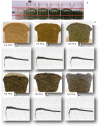Microalgae Proteins as Sustainable Ingredients in Novel Foods: Recent Developments and Challenges
- PMID: 38472846
- PMCID: PMC10930894
- DOI: 10.3390/foods13050733
Microalgae Proteins as Sustainable Ingredients in Novel Foods: Recent Developments and Challenges
Abstract
Microalgae are receiving increased attention in the food sector as a sustainable ingredient due to their high protein content and nutritional value. They contain up to 70% proteins with the presence of all 20 essential amino acids, thus fulfilling human dietary requirements. Microalgae are considered sustainable and environmentally friendly compared to traditional protein sources as they require less land and a reduced amount of water for cultivation. Although microalgae's potential in nutritional quality and functional properties is well documented, no reviews have considered an in-depth analysis of the pros and cons of their addition to foods. The present work discusses recent findings on microalgae with respect to their protein content and nutritional quality, placing a special focus on formulated food products containing microalgae proteins. Several challenges are encountered in the production, processing, and commercialization of foods containing microalgae proteins. Solutions presented in recent studies highlight the future research and directions necessary to provide solutions for consumer acceptability of microalgae proteins and derived products.
Keywords: extraction; in vitro digestibility; microalgae; microalgae-enriched foods; sustainable proteins.
Conflict of interest statement
The authors declare no conflict of interest.
Figures






References
-
- Falcon W.P., Naylor R.L., Shankar N.D. Rethinking Global Food Demand for 2050. Popul. Dev. Rev. 2022;48:921–957. doi: 10.1111/padr.12508. - DOI
-
- Brasil B.d.S.A.F., de Siqueira F.G., Salum T.F.C., Zanette C.M., Spier M.R. Microalgae and Cyanobacteria as Enzyme Biofactories. Algal Res. 2017;25:76–89. doi: 10.1016/j.algal.2017.04.035. - DOI
Publication types
LinkOut - more resources
Full Text Sources
Miscellaneous

